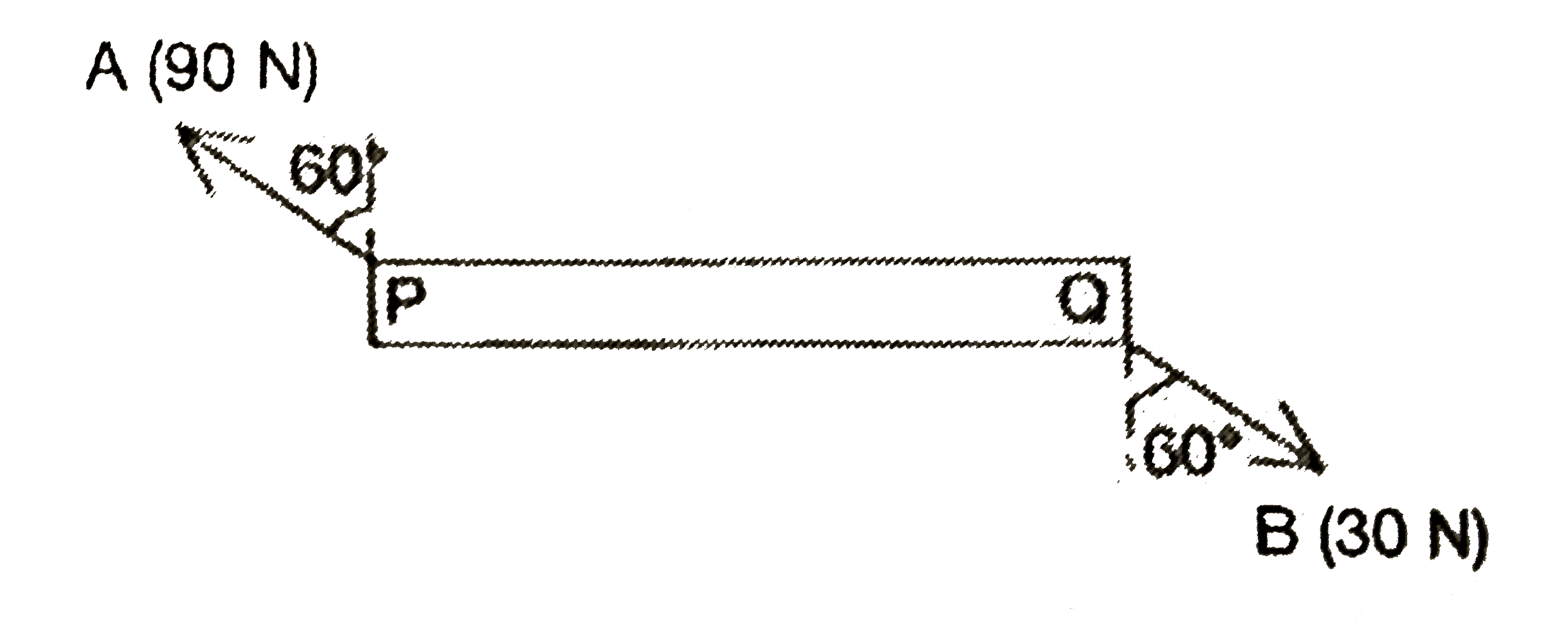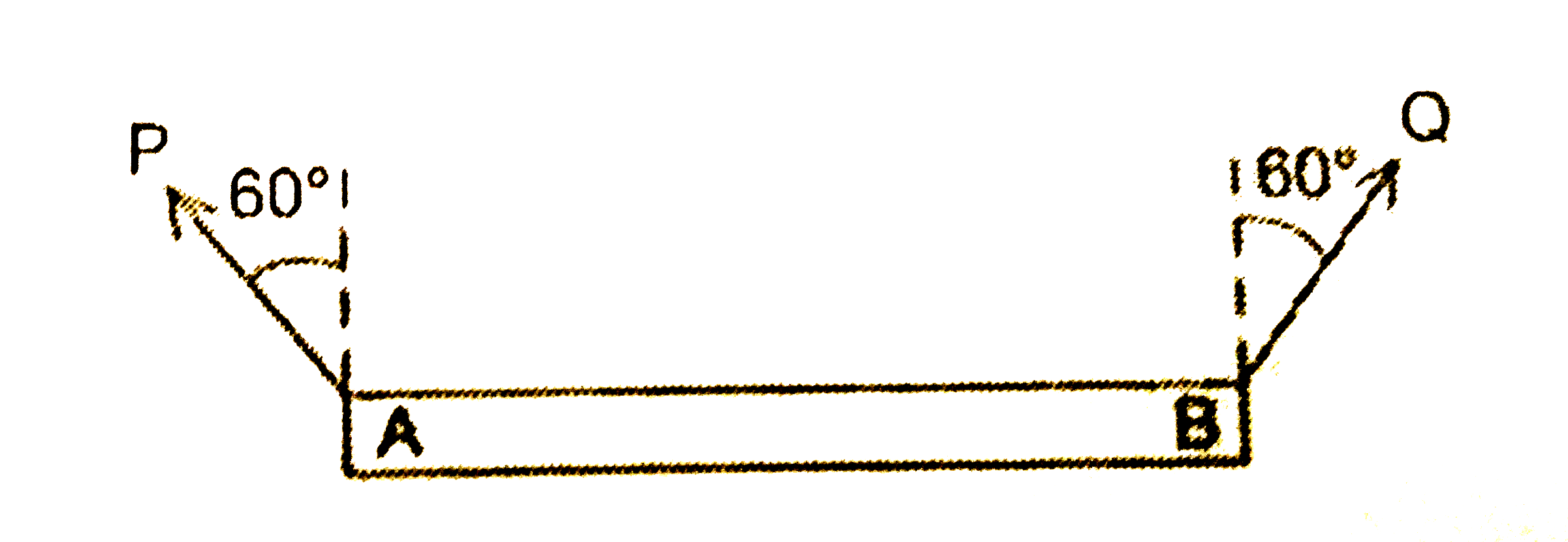If two forces of 5 N each are acting along X and Y axes, then the magnitude and direction of resultant is
5√2,π/3
5√2,π/4
−5√2,π/3
−5√2,π/4
The correct Answer is:B
To solve the problem of finding the magnitude and direction of the resultant of two forces of 5 N each acting along the X and Y axes, we can follow these steps:
Step 1: Identify the Forces
We have two forces:
- F1=5N acting along the X-axis (let's denote this as the i direction).
- F2=5N acting along the Y-axis (let's denote this as the j direction).
Step 2: Represent the Forces as Vectors
We can represent these forces as vectors:
- →F1=5^i
- →F2=5^j
Step 3: Add the Vectors
To find the resultant vector →R, we add the two vectors:
→R=→F1+→F2=5^i+5^j
Step 4: Calculate the Magnitude of the Resultant
The magnitude of the resultant vector →R can be calculated using the Pythagorean theorem:
|→R|=√(5)2+(5)2=√25+25=√50=5√2N
Step 5: Calculate the Direction of the Resultant
To find the direction of the resultant vector, we can use the tangent of the angle θ it makes with the X-axis:
tanθ=OppositeAdjacent=F2F1=55=1
Thus, θ=tan−1(1)=π4 radians or 45∘.
Final Result
The magnitude of the resultant force is 5√2N and the direction is 45∘ (or π4 radians) from the X-axis.
---
We have two forces:
- F1=5N acting along the X-axis (let's denote this as the i direction).
- F2=5N acting along the Y-axis (let's denote this as the j direction).
We can represent these forces as vectors:
- →F1=5^i
- →F2=5^j
To find the resultant vector →R, we add the two vectors:
→R=→F1+→F2=5^i+5^j
The magnitude of the resultant vector →R can be calculated using the Pythagorean theorem:
|→R|=√(5)2+(5)2=√25+25=√50=5√2N
To find the direction of the resultant vector, we can use the tangent of the angle θ it makes with the X-axis:
tanθ=OppositeAdjacent=F2F1=55=1
Thus, θ=tan−1(1)=π4 radians or 45∘.
The magnitude of the resultant force is 5√2N and the direction is 45∘ (or π4 radians) from the X-axis.
Topper's Solved these Questions
- BOOK - ERRORLESS CHAPTER - NEWTONS LAWS OF MOTIONEXERCISE - Motion of Connected Bodies23videos
NEWTONS LAWS OF MOTION
- BOOK - ERRORLESS CHAPTER - NEWTONS LAWS OF MOTIONEXERCISE - Critical Thinking19videos
NEWTONS LAWS OF MOTION
- BOOK - ERRORLESS CHAPTER - NEWTONS LAWS OF MOTIONEXERCISE - Conservation of Linear Momentum and Impulse27videos
NEWTONS LAWS OF MOTION
- BOOK - ERRORLESS CHAPTER - MOTION IN TWO DIMENSIONEXERCISE - Exercise319videos
MOTION IN TWO DIMENSION
- BOOK - ERRORLESS CHAPTER - ROTATIONAL MOTIONEXERCISE - Practice Problems (Problems based on motion of connected mass)10videos
ROTATIONAL MOTION
Similar Questions
ABCD is a rigid square of side 1 metre. Forces of 2,5, 6 and 3 kg wt. act along the sides AB, BC, CD and DA respectively and two forces of 4√2kg. wt. each act along AC and DB. The magnitude, direction and line of action of the resultant are ........... , ............
View SolutionA uniform metallic rod AB of length 1.4 m is lifted by two forces P and Q acting along the directions as shown in the figure. If the magnitudes of P and Q are 20 N and 50 N, respectively, find the magnitude and the position of the resultant normal force that acts on the rod.
 View Solution
View Solution
Knowledge Check
- Question 1 - Select One
The forces each of 20N act on a body at 120∘ The magnitude and direction of resultant is
A20N,ϕ=60∘B20√2N,ϕ=60∘C10√2N,ϕ=0∘D10√2N,ϕ=120∘ - Question 2 - Select One
If two forces each of magnitude 20N, are acting on a particle such that the first force (→E1) is acting along east direction and the second force (vercF2) is acting along the direction 60∘ north of west, then the magnitude of resultant force on particle is
A20NB20√3NC20√3NDNone of these - Question 3 - Select One
The sum of the magnitudes of two forces acting at a point is 18 and the magnitude of their resultant is 12. If the resultant is at 90∘ with the force of smaller magnitude, then their magnitudes are
A3, 15B4, 14C5, 13D6,12
A uniform metallic rod PQ of length 2 m is acted upon by two forces A and B along the directions as shown in the figure. Find the magnitude and position of the resultant normal force that acts on the rod.
 View Solution
View SolutionThe sum of the magnitudes of two forces acting at a point is 18 and the magnitude of their resultant is 12. If the resultant is at 90∘ with the force of smaller magnitude, What are the magnitudes of forces?
View SolutionA body of mass 5 kg is acted upon by two perpendicular forces of 4 N and 3 N. What is the magnitude and direction of acceleration ?
View SolutionIf two forces are acting at a point such that the magnitude of each force is 2 N and the magnitude of their resultant is also 2 N, then the angle between the two forces is
View SolutionIf two forces are acting at a point such that the magnitude of each force is 2N and the magnitude of their resultant is also 2N, then the angle between the two forces is
View Solution

